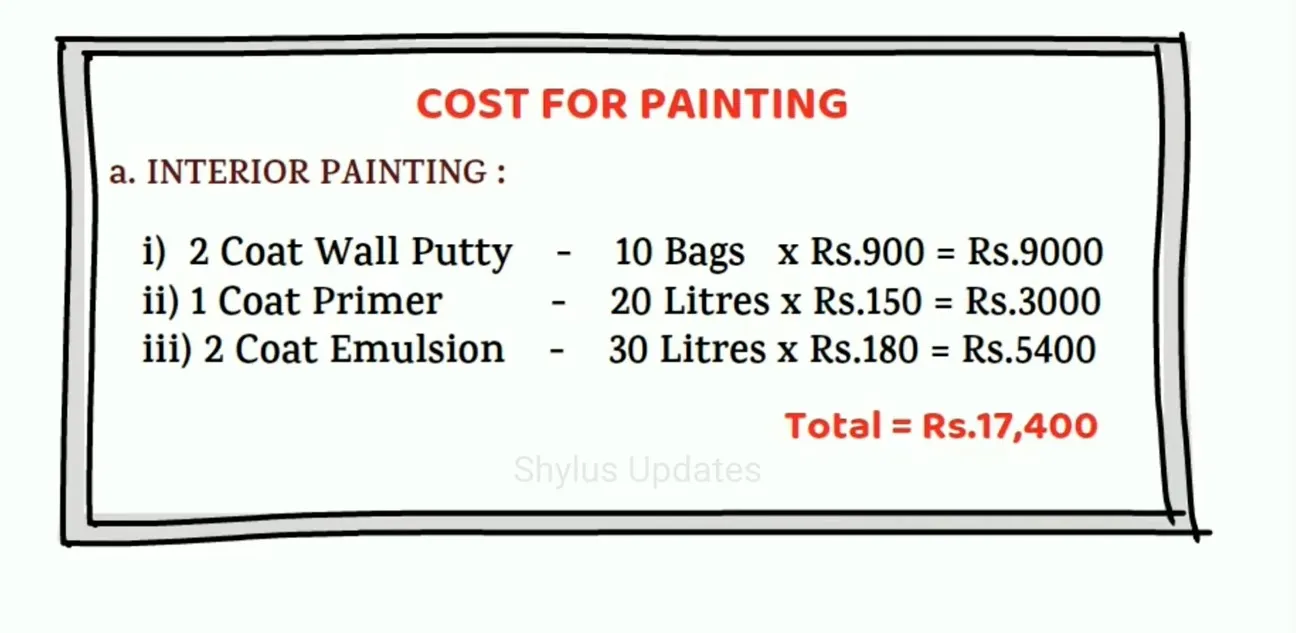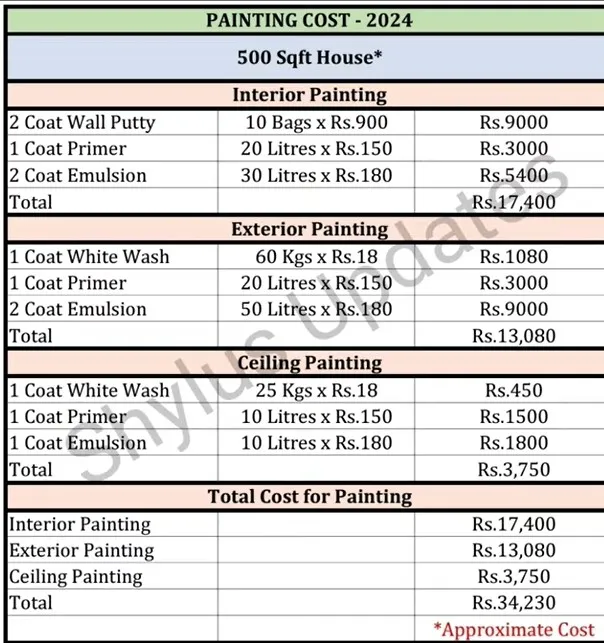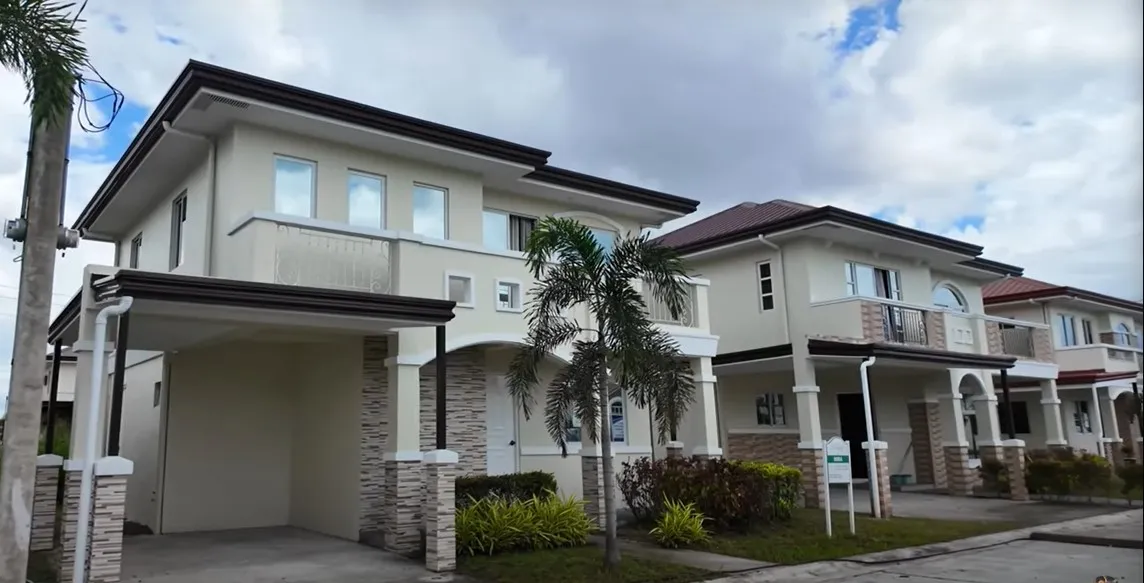Painting a 3-bedroom house typically costs between $2,500 and $4,500. Prices vary based on location, paint quality, and labor.
Painting your home is a significant investment that enhances its aesthetic appeal and market value. The cost to paint a 3-bedroom house depends on several factors, including the size of the house, the quality of the paint, and labor costs in your area.
Professional painters often provide estimates based on square footage, prep work needed, and the number of coats required. Choosing high-quality paint and experienced painters can ensure a durable and beautiful finish. Budgeting for this project is crucial to avoid unexpected expenses. Understanding these factors helps you make an informed decision and achieve the desired look for your home.
Factors Affecting Cost
Painting a 3-bedroom house can be a significant investment. The cost can vary based on several factors. Understanding these factors can help you budget better. This guide will explain the key elements that affect the cost.
Size Of The House
The size of the house is a major factor. Larger homes require more paint and more time to complete. A bigger house will naturally cost more. Here are some aspects to consider:
- Total square footage: More square footage means more paint.
- Number of floors: Multi-story homes need extra care.
- Exterior vs. Interior: Painting the exterior usually costs more.
Below is a general estimate:
|
House Size (sq ft) |
Estimated Cost |
|
1,000 – 1,500 |
$2,000 – $3,000 |
| 1,500 – 2,000 |
$3,000 – $4,500 |
| 2,000 – 2,500 |
$4,500 – $6,000 |
Number Of Rooms
The number of rooms impacts the cost too. More rooms mean more surfaces to cover. Each room has its own corners and trims. These details require extra work. Here are some points to think about:
- Bedrooms: More bedrooms, more walls to paint.
- Bathrooms: Bathrooms need special moisture-resistant paint.
- Kitchens: Kitchens often have more cabinets and fixtures.
Below is an average cost estimate:
|
Number of Rooms |
Estimated Cost |
|
3 – 5 rooms |
$1,500 – $3,000 |
| 6 – 8 rooms |
$3,000 – $5,000 |
| 9 – 12 rooms |
$5,000 – $8,000 |
Condition Of The Walls
The condition of the walls can change the cost. Walls in poor condition need more preparation. This includes cleaning, sanding, and priming. Here are some factors to consider:
- Cracks and holes: Repairing these adds to the cost.
- Old paint: Removing old paint takes time.
- Mold or mildew: Special treatments are needed for these issues.
Below is a cost estimate based on wall condition:
|
Wall Condition |
Estimated Cost |
|
Good |
$1,500 – $2,500 |
| Fair |
$2,500 – $4,000 |
| Poor |
$4,000 – $6,000 |
Ceiling Height
Ceiling height can also affect the cost. Higher ceilings require more paint and more effort. Painters may need special equipment. Here are some things to think about:
- Standard ceilings: Usually around 8 feet high.
- High ceilings: 10 feet or more.
- Vaulted ceilings: These can be very tall and complex.
Below is a cost estimate based on ceiling height:
|
Ceiling Height |
Estimated Cost |
|
8 feet |
$1,500 – $2,500 |
| 10 feet |
$2,500 – $4,000 |
| Vaulted |
$4,000 – $6,000 |
Types Of Paint
Painting a 3-bedroom house can change its look. The cost depends on many things. One key factor is the type of paint used. There are different paints for inside and outside. The quality of the paint also matters. Understanding these details will help you make the right choice.
Interior Paint
Interior paint is for the inside of the house. It comes in many types and colors. Choosing the right one is important. Here are some common types:
- Matte Paint: No shine, easy to clean, hides flaws.
- Eggshell Paint: Slight shine, durable, good for living rooms.
- Satin Paint: More shine, resistant to moisture, good for kitchens.
- Semi-Gloss Paint: Shiny and durable, great for bathrooms.
The cost of interior paint can vary. Prices range from $15 to $50 per gallon. Labor costs add to the price. Most painters charge by the hour. The average cost is around $30 to $60 per hour. A 3-bedroom house might need 10 to 15 gallons of paint. Plan for a total cost of $300 to $750 for paint alone.
Exterior Paint
Exterior paint protects the house from weather. It needs to be strong and long-lasting. There are different types of exterior paint:
- Latex Paint: Water-based, easy to clean, dries fast.
- Oil-Based Paint: Durable, good for wood, takes longer to dry.
- Acrylic Paint: Flexible, resists fading, good for all climates.
Exterior paint costs more than interior paint. Prices range from $20 to $70 per gallon. Labor costs are higher too. Painters might charge $40 to $80 per hour. A 3-bedroom house might need 15 to 20 gallons of paint. The total cost for paint can be $300 to $1,400.
Quality Of Paint
The quality of paint affects the look and durability. High-quality paint costs more but lasts longer. Here are some points to consider:
- Low-Quality Paint: Cheaper, needs more coats, fades faster.
- Medium-Quality Paint: Good balance of cost and durability, popular choice.
- High-Quality Paint: Expensive, fewer coats needed, lasts longer.
Choosing high-quality paint can save money in the long run. It reduces the need for frequent repainting. High-quality paint also looks better. It has a smoother finish and richer color. Most brands offer different grades of paint. Always check the label for details.
Labor Costs
Painting a 3-bedroom house involves several costs. One of the major expenses is labor. Labor costs can vary widely based on whether you hire professional painters or decide to do it yourself. Understanding these costs can help you make an informed decision.
Professional Painters
Hiring professional painters can save time and effort. Professional painters usually charge based on the size of the house and the type of paint used. On average, the cost to paint a 3-bedroom house can range from $1,500 to $4,500. This price includes labor and materials. Here are some factors that can affect the cost:
- Size of the House: Larger houses will cost more to paint.
- Type of Paint: Higher quality paints are more expensive.
- Number of Coats: More coats will increase the cost.
- Prep Work: Extensive prep work will add to the cost.
Professional painters bring their own supplies, which can also add to the cost. They usually work in teams to complete the job faster. Here’s a breakdown of average costs:
|
Service |
Average Cost |
|
Basic Paint Job |
$1,500 – $2,500 |
| High-Quality Paint Job |
$2,500 – $4,500 |
| Prep Work (per hour) |
$20 – $50 |
Diy Painting
Painting the house yourself can save money but requires effort and time. The cost of DIY painting is mainly for supplies. For a 3-bedroom house, you might spend between $300 and $800 on supplies. Here are some of the supplies you will need:
- Paint: Expect to spend $100 to $300 on paint.
- Brushes and Rollers: These can cost $20 to $50.
- Painter’s Tape: A roll costs around $5.
- Drop Cloths: These can range from $10 to $30.
- Primer: A gallon costs about $20 to $50.
DIY painting requires more time compared to hiring professionals. You’ll need to spend several weekends to complete the job. Here’s a rough timeline:
|
Task |
Time Required |
|
Prep Work |
1-2 days |
| Priming |
1 day |
| Painting |
2-3 days |
DIY painting can be satisfying but is labor-intensive. Consider your skills and time before deciding.
Preparation Work
Painting a 3-bedroom house can be a big task. It involves several steps to ensure a smooth and long-lasting finish. The first step is preparation work, which is crucial. This includes surface cleaning, wall repairs, and priming. Proper preparation ensures the paint adheres well and looks great.
Surface Cleaning
Before painting, the walls need to be clean. Dirt, dust, and grease can prevent paint from sticking well. Surface cleaning involves washing the walls with soap and water. For tougher stains, a mixture of vinegar and water can be used. It is important to let the walls dry completely before moving on to the next step.
Here are some steps for effective surface cleaning:
- Remove all furniture from the room.
- Cover the floor and any remaining items with drop cloths.
- Use a sponge or cloth to wash the walls with soapy water.
- Rinse the walls with clean water to remove soap residue.
- Allow the walls to dry completely.
Proper cleaning ensures a smooth and professional paint finish. Skipping this step can lead to peeling or uneven paint.
Wall Repairs
Walls often have cracks, holes, or dents. These imperfections need to be fixed before painting. Filling these gaps ensures a smooth surface for painting. Use spackle or joint compound to fill small holes and cracks. For larger holes, a patch may be needed. Sand the repaired areas to make them smooth.
Here are the steps for wall repairs:
- Inspect the walls for any damage.
- Use a putty knife to apply spackle to small holes.
- For larger holes, use a patch kit.
- Once the spackle or patch is dry, sand the area smooth.
- Wipe the walls with a damp cloth to remove dust from sanding.
Wall repairs are vital for a professional-looking paint job. Any imperfections left on the wall will be visible after painting.
Priming
Priming the walls is an important step. Primer helps the paint adhere better to the surface. It also covers any stains or dark colors, providing a uniform base for the paint. Choose a high-quality primer for the best results.
Here are the steps for priming:
- Stir the primer thoroughly before use.
- Use a brush to apply primer to corners and edges.
- Use a roller for the larger wall areas.
- Apply a thin, even coat of primer.
- Allow the primer to dry completely before painting.
Priming ensures the paint color is vibrant and lasts longer. Skipping primer can lead to uneven paint and poor adhesion.
Additional Services
Painting a three-bedroom house is a significant task that requires careful planning and budgeting. Various factors influence the overall cost, including the size of the house, the quality of paint, and additional services that might be required. One must consider the costs associated with painting trim and baseboards, doors and windows, and cabinets. These additional services can significantly affect the total expenditure, but they also add a polished and professional look to your home.
Trim And Baseboards
Trim and baseboards often need special attention when painting a house. These elements add detail and elegance to rooms, but they can be tricky to paint. The cost to paint trim and baseboards in a three-bedroom house varies. Professionals usually charge between $1 to $3 per linear foot for trim and baseboards.
Here are some factors that affect the cost:
- Material type: Wood, MDF, or plastic
- Current condition: Need for sanding or priming
- Accessibility: Hard-to-reach areas may cost more
- Paint type: High-quality paint can be more expensive
Budgeting for these elements is crucial. Neglecting them can diminish the overall appearance of your freshly painted house.
Doors And Windows
Painting doors and windows can significantly enhance the look of your house. Professionals typically charge around $50 to $200 per door and $20 to $60 per window. The following factors influence the cost:
- Material of the door: Wood, metal, or fiberglass
- Number of panes: More panes mean more work
- Condition: Old windows and doors may need more prep work
- Type of paint: Exterior or interior paint
Painting doors and windows not only improves the aesthetic appeal but also contributes to the longevity of these elements. A well-painted door or window can withstand weather and wear and tear better.
Cabinets
Cabinets are another crucial part of a home that can greatly benefit from a fresh coat of paint. Painting cabinets in a three-bedroom house can cost between $1,200 to $7,000, depending on various factors such as:
- Number of cabinets: More cabinets mean higher costs
- Material: Wood, laminate, or metal
- Condition: Need for sanding, priming, or repairs
- Paint type: High-quality or specialty paint
A newly painted set of cabinets can transform the look of your kitchen or bathroom. It adds value to your home and makes these spaces more enjoyable to use.
Painting Techniques
Painting a 3 bedroom house can change its look. Many people want to know the cost of this task. Different techniques can affect the cost and time taken. The most common methods are using a roller, brush, or spray. Each method has its benefits and costs. Understanding these can help in making an informed decision.
Roller
Using a roller is a popular method for painting walls. Rollers cover large areas quickly. This makes them ideal for painting rooms. Rollers are affordable and easy to use. They are great for smooth and even coats. Rollers come in different sizes. Choose the right size for the job. Smaller rollers are good for tight spaces. Large rollers cover big areas fast.
Here are some benefits of using rollers:
- Fast application
- Even coverage
- Less paint splatter
- Easy to clean
Rollers also come with various nap lengths. Short naps are for smooth surfaces. Long naps are for rough surfaces. Always choose the correct nap for the best results.
Brush
Brushes are another common tool for painting. They are great for detailed work. Brushes can paint edges and corners well. They are also good for small touch-ups. Brushes come in different shapes and sizes. Each type of brush serves a specific purpose.
Here are some types of brushes:
- Flat brushes: Great for large, flat areas
- Angled brushes: Perfect for corners and edges
- Round brushes: Best for detailed work
Choosing the right brush is important. Quality brushes give a smooth finish. Cheap brushes may leave streaks. Brushes require more time to cover large areas. This may increase the overall cost and time.
Spray
Spray painting is a fast technique. It covers large areas quickly. Sprayers can give a smooth finish. They are ideal for painting exterior walls and large surfaces. Spray painting requires skill. It can be messy if not done right. Proper preparation is key. Cover all areas that should not be painted.
Here are some advantages of spray painting:
- Fast application
- Smooth finish
- Covers hard-to-reach areas
Spray painting can be expensive. Renting or buying a spray gun costs more than rollers or brushes. It also requires more paint. Always consider these factors when choosing the spray method.
Average Costs
Painting a 3 bedroom house can be a big project. Understanding the average costs can help you budget. Different factors affect the price. Size of the house, type of paint, and labor all play a part. Let’s break down the costs to paint a 3 bedroom house.
Per Room
Costs per room can vary. Each room might need different amounts of paint. The condition of the walls matters too. Here are some key points to consider:
- Small rooms: $300 – $500
- Medium rooms: $500 – $700
- Large rooms: $700 – $1,000
These prices include labor and materials. If walls need extra work, costs go up. Some rooms might need primer. Others might need more than one coat of paint. Ceilings and trims also add to the cost. Always check if these are included in the estimate.
Per Square Foot
Calculating costs per square foot is another way to budget. On average, painting costs range from $1 to $3 per square foot. Here’s a simple table to show how costs can add up:
|
Square Feet |
Cost Range |
|
1,000 sq ft |
$1,000 – $3,000 |
| 1,500 sq ft |
$1,500 – $4,500 |
| 2,000 sq ft |
$2,000 – $6,000 |
The type of paint affects the cost per square foot. High-quality paint costs more but lasts longer. Eco-friendly paints can also be pricier. Always ask your painter for a detailed quote. This helps you understand what you are paying for.
Total Cost
The total cost to paint a 3 bedroom house can vary widely. On average, expect to spend between $3,000 and $6,000. This includes all rooms, ceilings, and trims. Here is a breakdown of what might affect the total cost:
- Size of the house: Larger homes cost more.
- Type of paint: High-end paints increase costs.
- Labor costs: Skilled painters charge more.
- Extra work: Repairs and priming add to the total cost.
Always get multiple quotes. This helps you find the best price. Make sure the quote includes all details. Hidden costs can surprise you later. Budgeting carefully ensures you get the best value for your money.
Tips For Cost Savings
Painting a 3-bedroom house can be a big job. But, it doesn’t have to break the bank. By using some smart tips, you can save money and still get great results. Here are some ways to save on painting costs.
Compare Quotes
Always get quotes from multiple painters. This ensures you get the best price. Ask at least three painters for their rates. Make sure to ask about any hidden fees. Some painters charge extra for supplies. Others might include them in their quote.
Here are some questions to ask:
- What is included in the price?
- How long will the job take?
- Do you offer any discounts?
Check their reviews online. A painter with good reviews might charge more, but it could be worth it. Don’t always go for the cheapest option. Quality matters, too.
Do Some Prep Work
You can save money by doing some of the work yourself. Clean the walls before the painter arrives. This can save the painter time and you money. Fill any holes or cracks in the walls. Sand down rough spots.
Here are some tools you might need:
- Sandpaper
- Putty knife
- Cleaning supplies
By doing this prep work, the painter can start painting right away. This means less time spent on the job and lower costs for you.
Consider Partial Painting
Not all rooms may need a fresh coat of paint. Focus on the areas that need it the most. Painting only the main rooms can save you a lot. You can always paint the other rooms later when you have more money.
Here are some rooms to focus on:
- Living room
- Kitchen
- Main bedroom
By being selective, you can cut down on costs and still refresh your home. Sometimes, just painting one or two rooms can make a big difference.
Choosing A Painting Contractor
Painting a 3-bedroom house can be an exciting project. It can also be a daunting task. Choosing the right painting contractor is crucial. The right contractor can ensure a smooth and satisfactory experience. This guide will help you understand what to look for in a painting contractor.
Experience And Reputation
Experience and reputation are key factors. A contractor with many years of experience is likely to do a better job. Look for contractors who have been in business for at least five years. Experienced contractors have dealt with various challenges. This makes them better equipped to handle your project.
Reputation is also important. A good reputation means the contractor has satisfied clients. Check online reviews and ratings. Ask for references from previous clients. Talk to these clients about their experiences. Positive feedback is a good sign.
Here are some points to consider:
- Years in business
- Number of successful projects
- Client testimonials and reviews
Choose a contractor with a solid track record. This ensures you get quality work and peace of mind.
References And Portfolio
References and a portfolio are valuable resources. They provide insight into the contractor’s work. Ask the contractor for a list of references. Contact these references to ask about their experiences. Did the contractor complete the job on time? Was the quality of work satisfactory?
A portfolio showcases the contractor’s previous projects. It helps you see the quality of their work. Look for before and after photos. This gives you a clear idea of their skills. A good portfolio should have:
- Photos of various projects
- Details about the type of work done
- Client testimonials
Reviewing references and a portfolio helps you make an informed decision. It ensures you choose a contractor who meets your expectations.
Licensing And Insurance
Licensing and insurance are essential. They protect you and the contractor. A licensed contractor meets the required standards. This ensures they are qualified to do the job. Ask the contractor for proof of their license. Verify the license with local authorities.
Insurance is equally important. It covers any damages or accidents during the project. Ensure the contractor has both liability and worker’s compensation insurance. Liability insurance covers damages to your property. Worker’s compensation covers injuries to workers.
Here is a quick checklist:
- Verify the contractor’s license
- Check for liability insurance
- Confirm worker’s compensation insurance
Choosing a contractor with proper licensing and insurance gives you peace of mind. It ensures you are protected throughout the project.
Diy Vs Hiring A Professional
Painting a 3 bedroom house can be a big task. Deciding between DIY and hiring a professional is important. Each option has its own benefits and drawbacks. This guide helps you understand the costs and pros of each choice. It will also cover key factors to consider.
Pros Of Hiring A Professional
Professionals offer many benefits. They bring experience and expertise to the job. This ensures a high-quality finish.
Here are some key advantages:
- Quality Work: Professionals know how to prep surfaces and apply paint.
- Time-Saving: They complete the job faster than most DIYers.
- Less Stress: You don’t have to worry about the details.
Professionals also have access to better tools and materials. This can make a big difference in the final look. They can also offer warranties for their work.
Overall, hiring a professional can save you time and effort. It can also ensure a better result.
Pros Of Diy Painting
DIY painting has its own set of benefits. The most obvious is cost savings. You only pay for paint and supplies.
Here are some other advantages:
- Flexibility: You can work on your own schedule.
- Personal Touch: Customize the project to your liking.
- Learning Experience: Gain new skills and knowledge.
DIY painting can be a fun and rewarding project. It allows for complete control over the process. You can choose the exact colors and finishes you want.
However, be prepared for the work involved. It requires time, effort, and patience.
Factors To Consider
Several factors affect the cost and success of your painting project. These include:
- Size of the House: Larger houses need more paint and time.
- Condition of Walls: Damaged walls need extra prep work.
- Type of Paint: Different paints vary in price and quality.
The location also plays a role. Urban areas may have higher labor costs. Season can impact pricing too. Painters may charge more during peak seasons.
Lastly, consider your personal skills and availability. DIY is great if you enjoy hands-on work. Hiring a professional might be better if you lack time or skills.
Weighing these factors helps make the best choice for your project.
Conclusion
Painting a 3-bedroom house involves various factors that influence cost. Consider the size, paint quality, and labor fees. Always get multiple quotes to ensure a fair price. Proper planning and budgeting will help achieve your desired results. Happy painting!




